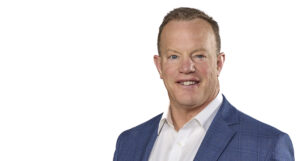Banks have long been at the center of personal finance, serving as the primary institution for checking accounts, savings deposits, and mortgages.
However, despite their deep relationships with customers, many banks are failing to fully capitalize on a major opportunity—converting depository clients into wealth management customers.
According to Cerulli Associates, 56% of bank clients who use traditional banking services do not have a wealth management relationship with their bank. This represents a massive untapped opportunity for wealth management units and trust departments within banks.
Breaking down siloes
Adam Stone, Trust Division President at National Exchange Bank & Trust, said the problem requires education, working together as a single unit, and breaking down work silos and cultural barriers within the bank.
“Success varies from bank to bank,” Stone said. “But banks must cross-sell through warm referrals. Our best sources of new business are our coworkers — our commercial lenders, our mortgage lenders, and even our tellers when they see big deposits. That relationship with the client is already there.”
Russ Morse, wealth management consultant and Director of RJM Consulting, who has more than 20 years in the trust world, echoed Stone’s sentiments and offered additional context into why internal referrals often fall short.
“It’s still a very siloed business,” Morse said. “The folks on the bank side don’t know what trust does, and the trust side really doesn’t know what the bank side does. There’s just a lack of education.”
With independent investment managers increasingly offering trust services, the competitive landscape is shifting fast. Banks that fail to adapt risk leaving billions of dollars in assets under management (AUM) on the table.
Wealth management growth lags deposits
Over the past decade, deposits at U.S. banks have more than doubled, yet the growth of wealth management assets has lagged significantly. Regional banks have seen their deposit base grow by over 240% since 2013, but their wealth management assets have only grown by 122% in the same period.
“Our competitors are everywhere,” Stone notes. “RIAs and independent firms are now putting on trust powers so they can do more. Our business is getting very competitive right now, and if we don’t evolve, we lose.”
This disparity suggests that banks are prioritizing deposit growth while failing to transition these assets into higher-value financial relationships such as trust and other forms of wealth management.
Morse added that part of the problem is bankers’ limited understanding of investments.
“Bankers don’t understand the value of market momentum,” he said. “They gravitate toward CDs and savings accounts. Someone will walk in with $400,000 they just inherited, and instead of referring them to the trust or brokerage side, the banker opens a CD.”
So, why aren’t more banks converting their depository clients?
1. Lack of internal referrals: One of the biggest obstacles banks face is internal referral inertia—getting retail bankers to refer clients to the trust and wealth division.
“Banks can be very good at referrals,” Stone explains. “But we’ve found that it depends on the market and the referring person. Some bankers are great at it, while others need more education on what to look for.”
Many banks do not actively train and incentivize their employees to identify high-net-worth (HNW) clients who may need wealth management.
2. Fragmented wealth management: Another problem is that retail bankers are often confused about who they should refer high-potential depositors to. Many banks have both an investment management or brokerage unit and a trust unit, with services that overlap.
If the retail bankers are confused, so is the consumer.
“We try to tell customers about trust and brokerage, and they’re different, and it’s confusing,” Stone said. “We need to consider buyer behavior and the psychology of purchasing. Consistency and simplicity is key.”
Morse agreed, noting that merging services is difficult but worthwhile.
“Culturally, brokers and trust officers are very different,” he said. “Trust is service-oriented. Brokers are hunters. The best outcomes come when you can shift the trust culture toward sales, so there’s better synergy between groups.”
3. Outdated technology and digital experience: The onboarding experience for bank wealth management clients is often slow and outdated, failing to meet the expectations of modern investors.
Many banks still use legacy technology that makes it difficult to quickly and efficiently transition banking customers into investment clients.
Key challenges include:
- Cumbersome onboarding processes that require too much paperwork.
- Lack of integration between banking and wealth platforms.
- Poor user experience in client portals compared to independent RIAs.
With 63% of bank executives citing technology as a major challenge, upgrading digital onboarding, streamlining account aggregation, and enhancing digital financial planning tools can significantly improve conversion rates.
How banks can maximize their wealth management potential
Banks tend to have good reputations and great brand equity in the markets they serve, Stone said. So how can they leverage those advantages to maximize business development on the wealth management side?
1. Implement stronger banker referral incentives: Banks that successfully convert depository clients into wealth management clients prioritize internal referral programs.
According to Cerulli, the most effective referral programs include:
- Flat cash bonuses for bankers who refer clients (used by 82% of banks).
- Percentage-based commissions on transferred assets (64% of banks).
- Recognition programs for top-referring bankers (27% of banks).
Morse noted that one of the challenges is how trust departments are limited in what they can offer in terms of incentive compensation.
“It’s hard to make it a real carrot,” he said. “The trust side is heavily regulated. Banks may need to simply mandate that referrals go to trust when appropriate.”
2. Unify wealth management: Banks, according to Stone, should consider simplifying and consolidating trust and brokerage into a single wealth management unit, or at least market them together.
Furthermore, banks must lead the conversation with brokerage and investment management and position trust services as a “value add.”
Repositioning in this way isn’t just better for business development, it also supports long-term, sustainable, multi-generational growth.
“If you’re going to compete and make money, it’s asset management,” Stone said. “We can’t predict when people pass away. Estate settlements are very laborious, and while they generate income, they don’t offer the same long-term revenue as an annuitized fee structure from investment management.”
3. Upgrade digital wealth onboarding: Bank clients expect the same digital experience for wealth management as they do for everyday banking.
Banks should focus on:
- E-signature onboarding to streamline account opening.
- AI-driven analytics to identify trust and investment opportunities.
- Integrated financial tools that give clients a full picture of their wealth.
Closing the gap
Banks are in a unique position to convert existing customers into long-term wealth management clients—but only if they take action.
By improving internal referral processes, upgrading technology, and repositioning trust services as accessible, banks can capture a much greater share of client assets and avoid leaving billions on the table.
The opportunity is there—banks just need to act.
Special thanks
Adam Stone is the Trust Division President at National Exchange Bank & Trust, where he helps lead the firm’s trust and wealth management strategies. His expertise in trust administration, estate planning, and investments makes him a leading voice on the future of bank trust services.
Russ Morse, wealth management consultant and Director of RJM Consulting, is a veteran bank trust consultant with over two decades of experience advising banks on trust profitability, integration, and cultural transformation. His insights into internal dynamics and operational bottlenecks offer a candid look at what it takes to build a high-functioning wealth business inside a bank.




